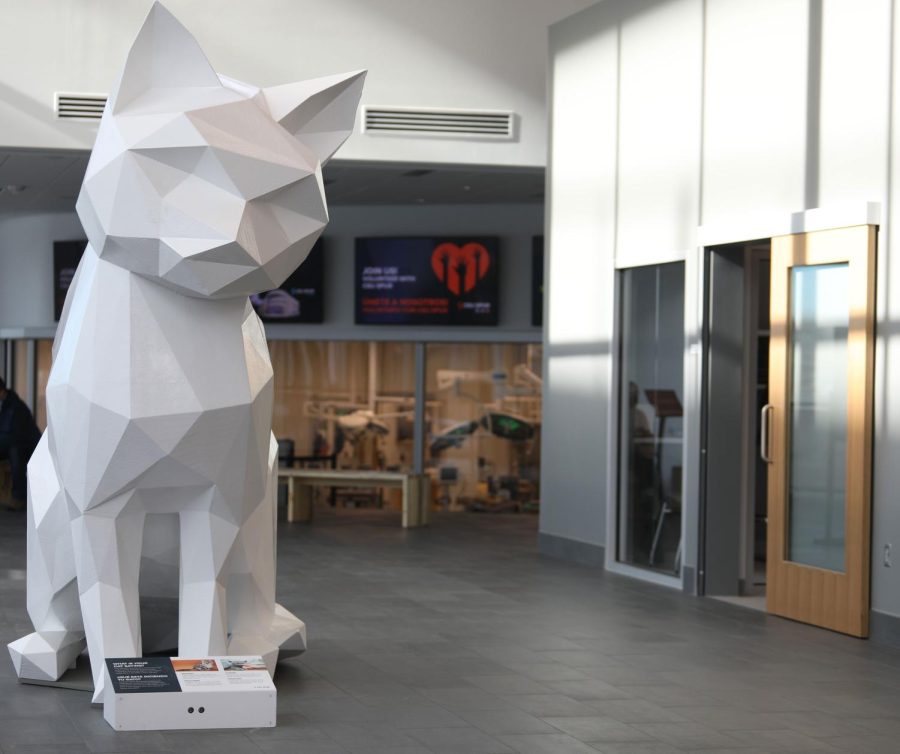Collegian | Serena Bettis
Colorado State University System Chancellor Tony Frank speaks about the impetus behind the CSU Spur campus at the ribbon-cutting ceremony of the first building, Vida Jan. 7. “This is a project for all of Colorado,” Frank said.
‘A place for everybody’: Understanding CSU Spur, the new Denver campus
March 21, 2022
Ren Wadsworth
In January, the Colorado State University System opened the first of three buildings on the CSU Spur campus, the System’s venture into the state capital.
CSU Spur is — and will become — a lot of different things to a lot of different people, but ultimately, it’s an educational hub that bridges the divide between Colorado’s rural and urban issues.

“The thing that is most important for us to be sure that the surrounding communities in Denver know is that this is really a place for everybody,” said Jocelyn Hittle, assistant vice chancellor for the CSU Spur campus and special projects. “So we want to welcome all kinds of learners. We want kids and families in this space; we want people to really feel welcome.”
Hittle said what the CSU community needs to know about Spur is similar.
“That this is a place for you,” Hittle said. “So faculty, staff, students from all of the System’s institutions have a role to play at Spur, and we want to be thinking creatively and collaboratively about how Spur can help to support, expand, elevate the work that people are already doing and offer new opportunities because it is intended to be a new space.”
Located at 4817 National Western Drive in Denver, Spur sits next to the National Western Complex between the Globeville and Elyria-Swansea neighborhoods. It is completely free and open to the public Monday through Saturday from 9 a.m. to 5 p.m.
The Spur website lists instructions for access via car, public transportation or on foot, and there is free parking for visitors. Due to continuing construction of both the Spur campus and the new National Western Complex, access routes may shift, so it’s best to check the website for updates before visiting.
Once visitors arrive, they can look forward to an interesting and educational experience.
“(It’s) a hard concept to describe, what we’re trying to do, because there’s really nothing like it,” Assistant Vice Chancellor for External Relations Tiana Kennedy said. “And so we talk about it in a way where it’s a little bit museum, it’s a little bit like (an) animal hospital — … the intention really is for it to be a place where there’s a ton to learn, but it’s also fun and engaging.”
“We want to spur your imagination, spur innovation within this space, spur people’s curiosity.” –Tiana Kennedy, assistant vice chancellor for external relations
CSU Spur consists of three buildings: Vida, Terra and Hydro. Vida opened in January 2022, and Kennedy said the Terra building should open in June 2022 with the Hydro building following in January 2023.
These are later dates than the System originally planned, as Kennedy said the construction is on schedule, but they determined they need more time to set up exhibits and programming between the completion of construction and opening to the public.
The campus theme centers around food, water and health, with each building focused on one of those topics.

Vida, which is the Spanish word for “life” and is the animal and human health building of the campus, features a Dumb Friends League animal hospital that offers subsidized veterinary care for community members, an Equine Sports Medicine and Rehabilitation Center and a Temple Grandin Equine Center. While each service sees private clients, the building design allows visitors to see veterinary medicine and equine therapy at work from observation windows.
Terra will focus on food and agriculture and will include a vertical garden, rooftop greenhouses, a learning and community kitchen and a food lab, Kennedy said.
Hydro will focus on water, with an outdoor space that overlooks the South Platte River offering opportunities for hands-on water research and a partnership with Denver Water, allowing for a look into their water quality and compliance testing.
Every component of each building comes with specific intentions, and the naming of CSU “Spur” has multiple meanings as well, Kennedy said.
Kennedy said “Spur” refers to the history of the campus location in that the area is part of the spur of a railroad and the historic site of Denver’s National Western Stock Show. Additionally, “Spur” functions as a call to action, representing CSU’s educational mission.
“We want to spur your imagination, spur innovation within this space, spur people’s curiosity,” Kennedy said. “We really want to communicate that this is a place where we’re trying to move things forward and kind of be a catalyst for students who visit and visitors just in general.”
The Globeville and Elyria-Swansea neighborhoods are some of Denver’s most diverse communities, according to History Colorado, and their histories revolve largely around industrial smelting and meatpacking plants, along with stockyards and major railroad lines.
Where the Vida building currently stands used to be home to a Swift and Company meatpacking plant, Kennedy said, and the intersecting railroads — which were active until a few years ago — sat behind the buildings and underneath the bridge that connects the Terra and Hydro buildings.
The current location of the National Western Complex has been active since Denver’s first National Western Stock Show in 1906, and the agricultural legacy of the Stock Show ties into CSU’s land-grant mission. A spur is a metal tool worn on riding boots used to guide an animal in a certain direction, giving CSU Spur’s name another connection to its mission and history.
